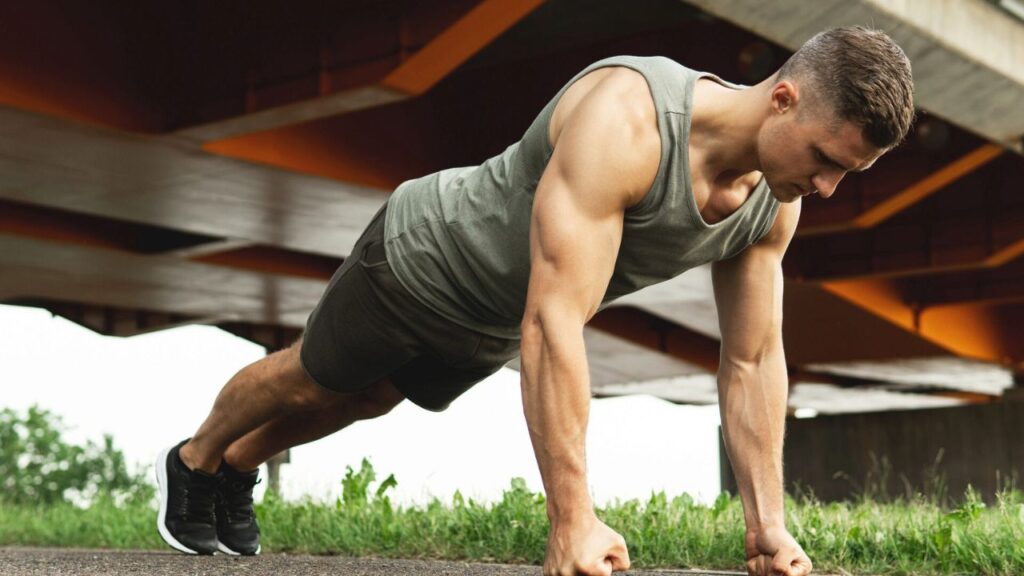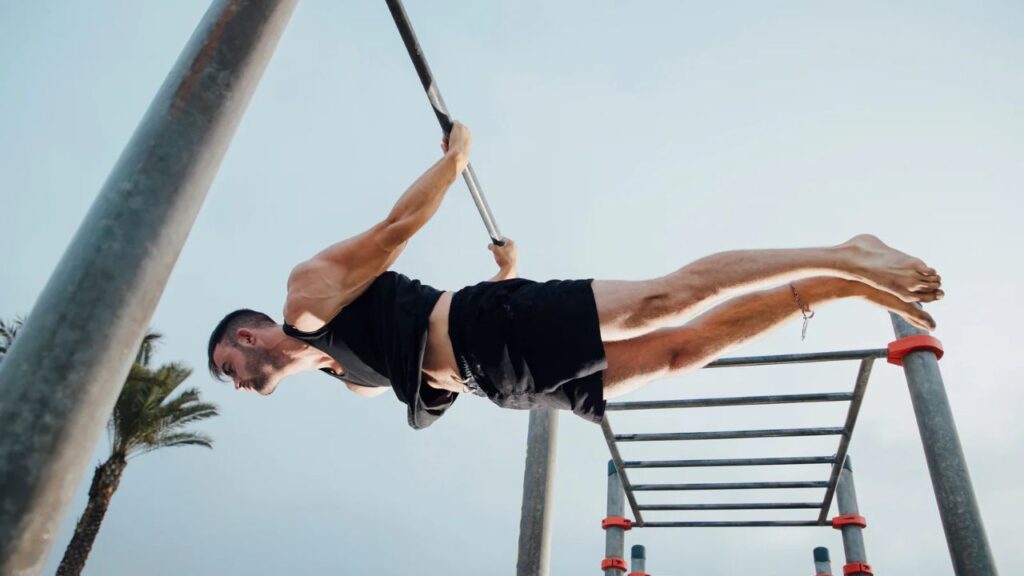INTRODUCTION
Calisthenics workouts are a growing craze in the fitness world these days. This is a workout style in which you use your own bodyweight to develop strength, balance, flexibility and endurance – without the use of any heavy equipment or machines.

The best thing is that you can do calisthenic workout anywhere – be it home, park or any open space. No need of gym or any expensive equipment. Only your body, some space and consistency is required.
The focus of this workout is not just on building muscle, but on improving functional strength, control and posture. Meaning it makes real-life movement easier, prevents injuries, and makes your body naturally strong and flexible.
TOP BENEFITS OF CALISTHENICS WORKOUT
If you are wondering whether calisthenics workouts are worth it or not, your doubt will be cleared after reading these benefits. Bodyweight training is not just an exercise method — it is a lifestyle that can take your overall fitness to the next level.
1. No Equipment Required
The biggest advantage is that you do not need any gym equipment for calisthenics workout. You can train every muscle group using just your bodyweight. Just a pull-up bar or a solid surface is enough to get started.
2. Cost-Effective & Accessible
There is no need to spend money on gym membership or machines. You can do Calisthenics at home, park, or any open space. It is accessible to every age group – whether you are a beginner or at an advanced level.
3. Builds Functional Strength
Unlike traditional weight training, calisthenics workouts develop your functional strength. Meaning, your body becomes stronger for real-life movements — like running, climbing, jumping, or carrying objects.
4. Fat Loss + Muscle Gain
This workout style simultaneously burns fat and builds lean muscle mass. Because it is a combination of high-intensity and compound movements, it boosts metabolism and burns more calories.
5. Improves Mobility and Flexibility
When you do calisthenics, your body becomes naturally flexible because you use the full range of motion, which strengthens joints and reduces the risk of injuries.

6. Better Body Control and Balance
You learn to control your bodyweight, which improves your overall balance and coordination. Skills like handstand or planche take your body-mind connection to the next level.
7. Boosts Mental Toughness and Discipline
Calisthenics workouts develop mental strength along with physical strength. When you work consistently to achieve a tough move like a muscle-up or front lever, you also learn discipline and patience.
8. Scalable For All Fitness Levels
Whether you’re a beginner or an athlete, calisthenics is for people of all levels. You can try an easier or tougher version of the same exercise — like starting with knee push-ups and progressing to full push-ups.
9. Time Efficient
Short on time? No problem! You can complete an effective calisthenics workout in 20-30 minutes. Because of the full-body movements, it doesn’t take you much time to work out different muscle groups.
10. Natural and Injury-Free Progress
Bodyweight exercises don’t put much stress on your joints, so the risk of injuries is low. And progress also occurs naturally — without steroids or shortcuts.
BEGINNER CALISTHENICS WORKOUT ROUTINE (NO EQUIPMENT NEEDED)
If you want to start a calisthenics workout but are confused about how to get started, then this section is for you. As a beginner, the most important thing is to focus on the basics, keep the form right and maintain consistency.

Step 1: Warm-up (5–7 Minutes)
A warm-up is essential before starting any calisthenics workout. It activates your muscles, reduces injury risk and improves performance.
- Basic Warm-up Routine:
- Jumping jacks – 2 mins
- Perform forward and backward arm rotations for 1 minute.
- Leg swings – 1 min
- Shoulder rolls – 1 min
- High knees – 1 min
- Wrist and ankle rotations – 1 min
Step 2: Foundational Calisthenics Exercises
These exercises are best for beginners. Each of these moves targets different parts of the body. Begin at a slow pace, maintain proper form, and slowly build up your repetitions.
1. Push-Ups (Chest, Triceps, Core)
- Start with incline push-ups if regular push-ups seem difficult.
- Reps: 3 sets of 8–12 reps
- Tip: Don’t let your hips sag; maintain a straight body line.
2. Bodyweight Squats (Legs, Glutes)
- Pay attention to form: Knees should not go past toes.
- Reps: 3 sets of 15–20 reps
- Progression: Try jump squats after 2 weeks for intensity.
3. Plank (Core Stability)
- Basic core strengthening move.
- Hold: 3 sets of 30–45 seconds
- Tip: Don’t arch your lower back. Keep spine neutral.
4. Glute Bridges (Glutes, Lower Back)
- Kneel on the floor, bend your knees, and lift your hips up.
- Reps: 3 sets of 12–15
- Great for building posterior chin strength.
5. Wall Push-Ups (Beginner Alternative)
- If ground push-up is difficult then start with wall push-ups.
- Reps: 3 sets of 15
- Slowly switch to knee push-ups, then full push-ups
6. Negative Pull-Ups (Back, Biceps)
- Jump into a chin-up position, then slowly lower down.
- Reps: 3 sets of 3–5 reps
- This will give you a better idea of full pull-ups.
INTERMEDIATE CALISTHENICS WORKOUT ROUTINE
When you are comfortable with movements like basic push-ups, squats, plank, then understand that you have reached the intermediate level. At this stage you should include progressive overload, harder variations and skill-based movements to take your calisthenics workout to the next level.

What Changes at the Intermediate Level?
- You try tougher variations (like diamond push-ups, archer pull-ups).
- Core exercises become more dynamic.
- Static holds and isometric training become very important.
- Skills like dips, L-sit, crow pose, etc. are practiced
You can follow this plan for week 4 to week 8.
Day 1 – Upper Body Strength
- Archer Push-Ups – 3 sets × 8–10 reps
- Do 3 sets of 6–8 reps of Negative Dips or Dips on a Straight Bar.
- Australian Pull-Ups (Feet Elevated) – 3 sets × 10–12 reps
- Diamond Push-Ups – 3 sets × 8–10 reps
- Perform Plank to Push-Up movement for 2 sets of 45 seconds each.
Day 2 – Lower Body + Core
- Go for 3 rounds of 12 dynamic jump squats each.
- Bulgarian Split Squats (use bench/chair) – 3 sets × 10 reps each leg
- Wall Sit Hold – 2 rounds × 60 sec
- Hanging Knee Raises (or lying if no bar) – 3 sets × 12
- Lying Leg Raises – 3 sets × 15
- Side Plank Hold – 30 sec per side
Day 3 – Rest or Light Movement (Yoga/Walk)
Day 4 – Pulling Focus
- Negative Pull-Ups or Assisted Pull-Ups – 3 sets × 5–6 reps
- Australian Rows (Under Table or Bar) – 3 sets × 10 reps
- Chin-Ups (If Possible) – 2 sets × 3–5 reps
- Do 3 sets of 10 reps of Reverse Snow Angels to target your back muscles.
- Dead Hang – 2 sets × 30 sec
Day 5 – Push Focus + Core
- Pseudo Planche Push-Ups – 3 sets × 6–8 reps
- Incline Dips (On Parallel Bars/Bench) – 3 sets × 8
- Hollow Body Hold – 3 sets × 30 sec
- Toe Taps or Flutter Kicks – 3 sets × 30 sec
- Slow Mountain Climbers – 2 sets × 45 sec
Day 6 – Skills & Static Holds Practice
- L-Sit on Parallettes or Floor – 3 sets × hold as long as possible
- Crow Pose / Frog Stand – 3 sets × 20–30 sec
- Wall Handstand (Assisted) – 3 rounds × hold
- Scapular Shrugs (Push-up or Pull-up style) – 3 sets × 10
- Light stretching & mobility drills for wrists, shoulders & hips
Day 7 – Rest
At the intermediate level your calisthenics workout becomes even more exciting. You build advanced strength, learn new skills, and gain complete control over your body. This stage demands discipline, patience, and passion — but the results are even more rewarding.
ADVANCED CALISHTHENICS TRAINING: MASTERING BODYWEIGHT STRENGTH
When you can perform the major movements at the intermediate level — like push-ups, dips, pull-ups, squats — with full control, you’re ready for an advanced calisthenics workout. Here it’s not just a game of strength, it’s also about control, balance, tension and skill mastery.
At this level the training becomes more technical – it puts a lot of load on your joints, tendons and muscles. So warm-up, mobility and recovery become even more important.
Training Principles for Advanced Athletes
High Tension, Low Reps:
- Focus on 3–6 reps of very high intensity (planche push-ups, one-arm push-ups etc.)
Longer Rest Periods:
- 90 sec to 3 min between sets for strength-based movements
Skill Practice Separately:
- Do not treat skills like reps; treat them like coordination drills
Joint Prep:
- Wrists, elbows, and shoulders need proper mobility & strengthening before attempting skills like planche or levers.
This is a 5-day split plan, which includes strength, skill and control.
Day 1 – Pull Mastery & Static Strength
- One-Arm Negative Pull-Ups – 3 sets × 3–4 reps
- Hit 3 sets of pull-ups, pushing for 5 tough reps each time.
- Front Lever Progression (Tuck to Full) – 4 sets × 10–15 sec hold
- Perform 5 reps per side of Archer Pull-Ups for a total of 3 sets.
- Dead Hang with Scapula Retraction – 2 sets × 45 sec
Day 2 – Push Strength & Planche Work
- Pseudo Planche Push-Ups (High Lean) – 3 sets × 6 reps
- Handstand Push-Ups (Wall or Free) – 3 sets × 4–6 reps
- Planche Lean Hold – 4 rounds × max hold
- Straight Bar Dips (Weighted Optional) – 3 sets × 8
- Wall Planche Tuck Hold – 3 attempts × max duration
Day 3: Core Strength & Explosive Leg Training
- L-Sit to V-Sit Progression (Parallettes or Floor) – 3 sets × max
- Do 3 sets of 10 Hanging Leg Raises, aiming to touch your toes to the bar.
- Do 5 controlled Dragon Flag reps per set for 3 total sets.
- Explosive Jump Squats – 3 sets × 10
- Pistol Squats (Weighted or Assisted) – 3 sets × 6 each leg
- Wall Handstand Hold – 2 min total hold (in sets)
Day 4 – Skill Focus Day (Low Reps, High Control)
- Front Lever Pulls (Partial ROM) – 3 sets
- Planche Hold or Straddle Planche (On Floor or Parallettes) – 3–4 sets
- Handstand Freestanding Practice (Wall Exit) – 15–20 min
- Muscle-Up Technique Work (Resistance Band if needed) – 4 sets
- Mobility & Stretching (Wrists, Shoulders, Hips) – 15 min
Day 5 – Push + Pull Combo (Full Body Integration)
- Do 2 to 4 reps of clean muscle-ups across 3 to 5 sets.
- Typewriter Pull-Ups – 3 sets × 6
- Hindu Push-Ups or Ring Dips – 3 sets × 8–10
- Plank to Full Planche Transition Drill – 4 sets
- Isometric Core Hold (L-Sit / V-Sit) – 3 sets × 30+ sec
Day 6 – Active Recovery / Mobility Work
- Deep stretches for hamstrings, hips, lats, shoulders
- Foam rolling (if available)
- Breathing + Stability drills
- Light jogging/jumping rope (5–10 min)
Day 7 – Rest / Complete Recovery
Advanced calisthenics workouts demand a serious level of discipline, strength and body control. Here gains are not just limited to muscles — it makes you mentally focused, physically strong and incredibly capable.
Read More: How Does Screen Time Affect Your Physical and Mental Health. How Its Badly Impacts Your Body and Mind
Conclusion
So brother, if you also want a functional, strong and skillful body that not only looks good but also works, then start your calisthenic workout routine today.
Whether you’re a beginner or an advanced athlete, calisthenics brings something new to you at every level — new goals, new skills, and new challenges. From push-ups to planches, every move tests your inner warrior.
In today’s time when there is a craze for gym memberships, heavy machines and supplements, calisthenics workout is such a raw and natural training system which not only makes you strong but also smart.
FAQs
1. What is a calisthenics ?
This is a bodyweight training system that helps build strength and control without the use of gym equipment.
2. Does this help in gaining muscles?
Yes, muscles will grow if you maintain the right form and try harder variations.
3. Calisthenics or Gym – Which is Better?
Both are effective. Calisthenics workouts focus on functional strength and body control.
4. Does calisthenics burn fat?
Yes, it is a full body movement which burns calories and helps in fat loss.
5. Is there an injury risk in calisthenics?
If you do not warm up or your form is wrong, you may get injured. Form and control are most important.
